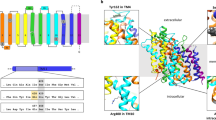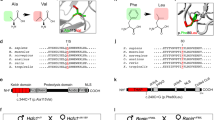Abstract
Inherited disorders of vitamin B12 (cobalamin) have provided important clues to how this vitamin, which is essential for hematological and neurological function, is transported and metabolized. We describe a new disease that results in failure to release vitamin B12 from lysosomes, which mimics the cblF defect caused by LMBRD1 mutations. Using microcell-mediated chromosome transfer and exome sequencing, we identified causal mutations in ABCD4, a gene that codes for an ABC transporter, which was previously thought to have peroxisomal localization and function. Our results show that ABCD4 colocalizes with the lysosomal proteins LAMP1 and LMBD1, the latter of which is deficient in the cblF defect. Furthermore, we show that mutations altering the putative ATPase domain of ABCD4 affect its function, suggesting that the ATPase activity of ABCD4 may be involved in intracellular processing of vitamin B12.
This is a preview of subscription content, access via your institution
Access options
Subscribe to this journal
Receive 12 print issues and online access
$209.00 per year
only $17.42 per issue
Buy this article
- Purchase on Springer Link
- Instant access to full article PDF
Prices may be subject to local taxes which are calculated during checkout





Similar content being viewed by others
Accession codes
References
Shani, N., Jimenez-Sanchez, G., Steel, G., Dean, M. & Valle, D. Identification of a fourth half ABC transporter in the human peroxisomal membrane. Hum. Mol. Genet. 6, 1925–1931 (1997).
Coelho, D. et al. Gene identification for the cblD defect of vitamin B12 metabolism. N. Engl. J. Med. 358, 1454–1464 (2008).
Rutsch, F. et al. Identification of a putative lysosomal cobalamin exporter altered in the cblF defect of vitamin B12 metabolism. Nat. Genet. 41, 234–239 (2009).
Rosenblatt, D.S., Hosack, A., Matiaszuk, N.V., Cooper, B.A. & Laframboise, R. Defect in vitamin B12 release from lysosomes: newly described inborn error of vitamin B12 metabolism. Science 228, 1319–1321 (1985).
Adzhubei, I.A. et al. A method and server for predicting damaging missense mutations. Nat. Methods 7, 248–249 (2010).
Wanders, R.J., Visser, W.F., van Roermund, C.W., Kemp, S. & Waterham, H.R. The peroxisomal ABC transporter family. Eur. J. Physiol. 453, 719–734 (2007).
Kemp, S. et al. ABCD1 mutations and the X-linked adrenoleukodystrophy mutation database: role in diagnosis and clinical correlations. Hum. Mutat. 18, 499–515 (2001).
Matsukawa, T. et al. Identification of novel SNPs of ABCD1, ABCD2, ABCD3, and ABCD4 genes in patients with X-linked adrenoleukodystrophy (ALD) based on comprehensive resequencing and association studies with ALD phenotypes. Neurogenetics 12, 41–50 (2011).
Kashiwayama, Y. et al. 70-kDa peroxisomal membrane protein related protein (P70R/ABCD4) localizes to endoplasmic reticulum not peroxisomes, and NH2-terminal hydrophobic property determines the subcellular localization of ABC subfamily D proteins. Exp. Cell Res. 315, 190–205 (2009).
Seeger, M.A. & van Veen, H.W. Molecular basis of multidrug transport by ABC transporters. Biochim. Biophys. Acta 1794, 725–737 (2009).
Rost, B., Yachdav, G. & Liu, J. The PredictProtein server. Nucleic Acids Res. 32, W321–W326 (2004).
Kikuchi, M. et al. Proteomic analysis of rat liver peroxisome: presence of peroxisome-specific isozyme of Lon protease. J. Biol. Chem. 279, 421–428 (2004).
Islinger, M., Lüers, G.H., Li, K.W., Loos, M. & Völkl, A. Rat liver peroxisomes after fibrate treatment. A survey using quantitative mass spectrometry. J. Biol. Chem. 282, 23055–23069 (2007).
Wiese, S. et al. Proteomics characterization of mouse kidney peroxisomes by tandem mass spectrometry and protein correlation profiling. Mol. Cell. Proteomics 6, 2045–2057 (2007).
Gloeckner, C.J. et al. Human adrenoleukodystrophy protein and related peroxisomal ABC transporters interact with the peroxisomal assembly protein PEX19p. Biochem. Biophys. Res. Commun. 271, 144–150 (2000).
Borths, E.L., Poolman, B., Hvorup, R.N., Locher, K.P. & Rees, D.C. In vitro functional characterization of BtuCD-F, the Escherichia coli ABC transporter for vitamin B12 uptake. Biochemistry 44, 16301–16309 (2005).
Beedholm-Ebsen, R. et al. Identification of multidrug resistance protein 1 (MRP1/ABCC1) as a molecular gate for cellular export of cobalamin. Blood 115, 1632–1639 (2010).
Verrier, P.J. et al. Plant ABC proteins—a unified nomenclature and updated inventory. Trends Plant Sci. 13, 151–159 (2008).
Aittoniemi, J. et al. SUR1: a unique ATP-binding cassette protein that functions as an ion channel regulator. Phil. Trans. R. Soc. Lond. B 364, 257–267 (2009).
Suormala, T. et al. The cblD defect causes either isolated or combined deficiency of methylcobalamin and adenosylcobalamin synthesis. J. Biol. Chem. 279, 42742–42749 (2004).
Watkins, D. Cobalamin metabolism in methionine-dependent human tumour and leukemia cell lines. Clin. Invest. Med. 21, 151–158 (1998).
Yao, J. & Shoubridge, E.A. Expression and functional analysis of SURF1 in Leigh syndrome patients with cytochrome c oxidase deficiency. Hum. Mol. Genet. 8, 2541–2549 (1999).
Litzkas, P., Jha, K.K. & Ozer, H.L. Efficient transfer of cloned DNA into human diploid cells: protoplast fusion in suspension. Mol. Cell. Biol. 4, 2549–2552 (1984).
Alfares, A. et al. Combined malonic and methylmalonic aciduria: exome sequencing reveals mutations in the ACSF3 gene in patients with a non-classic phenotype. J. Med. Genet. 48, 602–605 (2011).
Li, H., Ruan, J. & Durbin, R. Mapping short DNA sequencing reads and calling variants using mapping quality scores. Genome Res. 18, 1851–1858 (2008).
Li, H. & Durbin, R. Fast and accurate short read alignment with Burrows-Wheeler transform. Bioinformatics 25, 1754–1760 (2009).
Li, H. et al. The Sequence Alignment/Map format and SAMtools. Bioinformatics 25, 2078–2079 (2009).
Cuthbert, A.P. et al. Construction and characterization of a highly stable human: rodent monochromosomal hybrid panel for genetic complementation and genome mapping studies. Cytogenet. Cell Genet. 71, 68–76 (1995).
Hunt, J.D. Evaluation of phenotypic alteration by microcell-mediated chromosome transfer. Anal. Biochem. 238, 107–116 (1996).
Fowler, B. & Jakobs, C. Post- and prenatal diagnostic methods for the homocystinurias. Eur. J. Pediatr. 157, S88–S93 (1998).
Miousse, I.R. et al. Clinical and molecular heterogeneity in patients with the cblD inborn error of cobalamin metabolism. J. Pediatr. 154, 551–556 (2009).
Fowler, B., Whitehouse, C., Wenzel, F. & Wraith, J.E. Methionine and serine formation in control and mutant human cultured fibroblasts: evidence for methyl trapping and characterization of remethylation defects. Pediatr. Res. 41, 145–151 (1997).
Weraarpachai, W. et al. Mutation in TACO1, encoding a translational activator of COX I, results in cytochrome c oxidase deficiency and late-onset Leigh syndrome. Nat. Genet. 41, 833–837 (2009).
Lerner-Ellis, J.P. et al. Identification of the gene responsible for methylmalonic aciduria and homocystinuria, cblC type. Nat. Genet. 38, 93–100 (2006).
Stucki, M. et al. Molecular mechanisms leading to three different phenotypes in the cblD defect of intracellular cobalamin metabolism. Hum. Mol. Genet. 21, 1410–1418 (2012).
Acknowledgements
We thank S. Lutz for technical assistance in carrying out enzyme assays and K. Locher for fruitful discussions. We thank J. Gärtner (University of Göttingen) for providing cell lines with peroxisomal defects and R. Newbold (Brunel University) for providing the mouse-human monochromosomal hybrid cell lines used for microcell-mediated chromosome transfer. This work was supported by the Swiss National Science Foundation (320000_122568 and 31003A_138521) and by the Deutsche Forschungsgemeinschaft (RU816/5-1). D.S.R. is supported by the Canadian Institutes for Health Research (15078).
Author information
Authors and Affiliations
Contributions
M.R.B., F.R., B.F. and D.S.R. supervised the project. M.R.B., F.R., B.F., D.S.R., J.C.K., T.S. and D.C. designed the study, analyzed the data and wrote the manuscript. T.S., M.d.M. and D.C. performed microcell-mediated chromosome transfer. M.S., D.C. and M.F. designed primers and built constructs. M.d.M., I.B., J.C.K., I.R.M., D.W. and D.C. performed sequencing analysis. J.M., P.N. and H.T. performed whole-exome sequencing. S.F. and E.A.S. performed immortalization and stable transduction of fibroblasts. T.S., P.B., J.C.K. and D.W. performed somatic cell complementation, enzymatic assays, Cbl coenzyme synthesis and expression studies. H.R., I.B. and D.C. analyzed the subcellular localization of ABCD4. D.C. and P.B. performed protein blots. W.H. and D.C. analyzed the structure of ABCD4. N.L., M.P. and E.M. provided clinical information about the affected individuals. All authors discussed the results and reviewed the manuscript.
Corresponding authors
Ethics declarations
Competing interests
The authors declare no competing financial interests.
Supplementary information
Supplementary Text and Figures
Supplementary Figures 1 and 2, Supplementary Tables 1–7 and Supplementary Note (PDF 126 kb)
Rights and permissions
About this article
Cite this article
Coelho, D., Kim, J., Miousse, I. et al. Mutations in ABCD4 cause a new inborn error of vitamin B12 metabolism. Nat Genet 44, 1152–1155 (2012). https://doi.org/10.1038/ng.2386
Received:
Accepted:
Published:
Issue Date:
DOI: https://doi.org/10.1038/ng.2386
This article is cited by
-
Treatable inherited metabolic disorders causing intellectual disability: 2021 review and digital app
Orphanet Journal of Rare Diseases (2021)
-
Integrated analysis of single-cell RNA-seq and bulk RNA-seq unravels tumour heterogeneity plus M2-like tumour-associated macrophage infiltration and aggressiveness in TNBC
Cancer Immunology, Immunotherapy (2021)
-
Assessment of cellular cobalamin metabolism in Gaucher disease
BMC Medical Genetics (2020)
-
Genome-wide association analyses identify known and novel loci for teat number in Duroc pigs using single-locus and multi-locus models
BMC Genomics (2020)
-
Polyneuropathy in Gaucher disease type 1 and 3 – a descriptive case series
Scientific Reports (2019)



